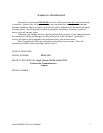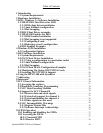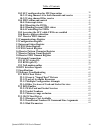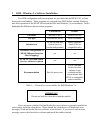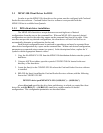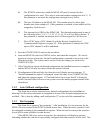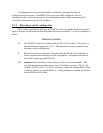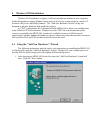
S# The PCMCIA socket into which the MPAP-100 must be inserted for this
configuration to be used. This value is a decimal number ranging from 0 to 15. If
this parameter is not used, the configuration can apply to any socket.
B# The base I/O address of the MPAP-100. This number must be a three-digit
hexadecimal value ending in 0. If this parameter is omitted, a base address will be
assigned by Card Services.
I# The interrupt level (IRQ) of the MPAP-100. This decimal number must be one of
the following values: 3, 4, 5, 7, 9, 10, 11, 12, 14, 15, or 0 if no IRQ is desired. If
this parameter is omitted, an interrupt level will be assigned by Card Services.
C Drive SYNC input of SCC channel A with the Remote Loopback bit of
Communications Register (see page 39). If this parameter is omitted, the SYNC
input of SCC channel A will be undefined.
5. Save the CONFIG.SYS file and exit the text editor.
6. Insert an MPAP-100 card in a PCMCIA socket, and reboot the computer. (If a card is
present in a socket at boot time, the card's configuration is reported on the screen as the
client driver loads. This feature can be used to verify the changes just made to the
CONFIG.SYS file.)
7. If the Client Driver reports the desired configuration, the installation process is complete
and the MPAP-100 may be removed from the system if desired.
8. If configuration of the card fails, the client driver will display an error message. If
"Invalid command line option" is displayed, correct the entry in the CONFIG.SYS file
and reboot the computer again. If "Card and Socket Services not found" is displayed,
install Card and Socket Services on the system or use the enabler program instead of the
client driver.
3.1.2 Auto Fallback configuration
The client driver can be instructed to try desired configurations first but fallback to
allowing Card Services to determine a configuration if none of the desired configurations are
available. This is done by adding a null configuration "()" to the end of the command line.
3.1.3 Hot Swapping
The client driver supports "hot swapping." After installation, it is not necessary for the
MPAP-100 to be inserted in the PCMCIA socket at boot time. When the card is inserted, it will
be configured according to the command line options. When the card is removed, the resources
it used will be made available for other devices.
If the MPAP-100 is in a socket at boot time, the client driver will display a message
indicating whether the card can be successfully configured and what resources will be used. This



